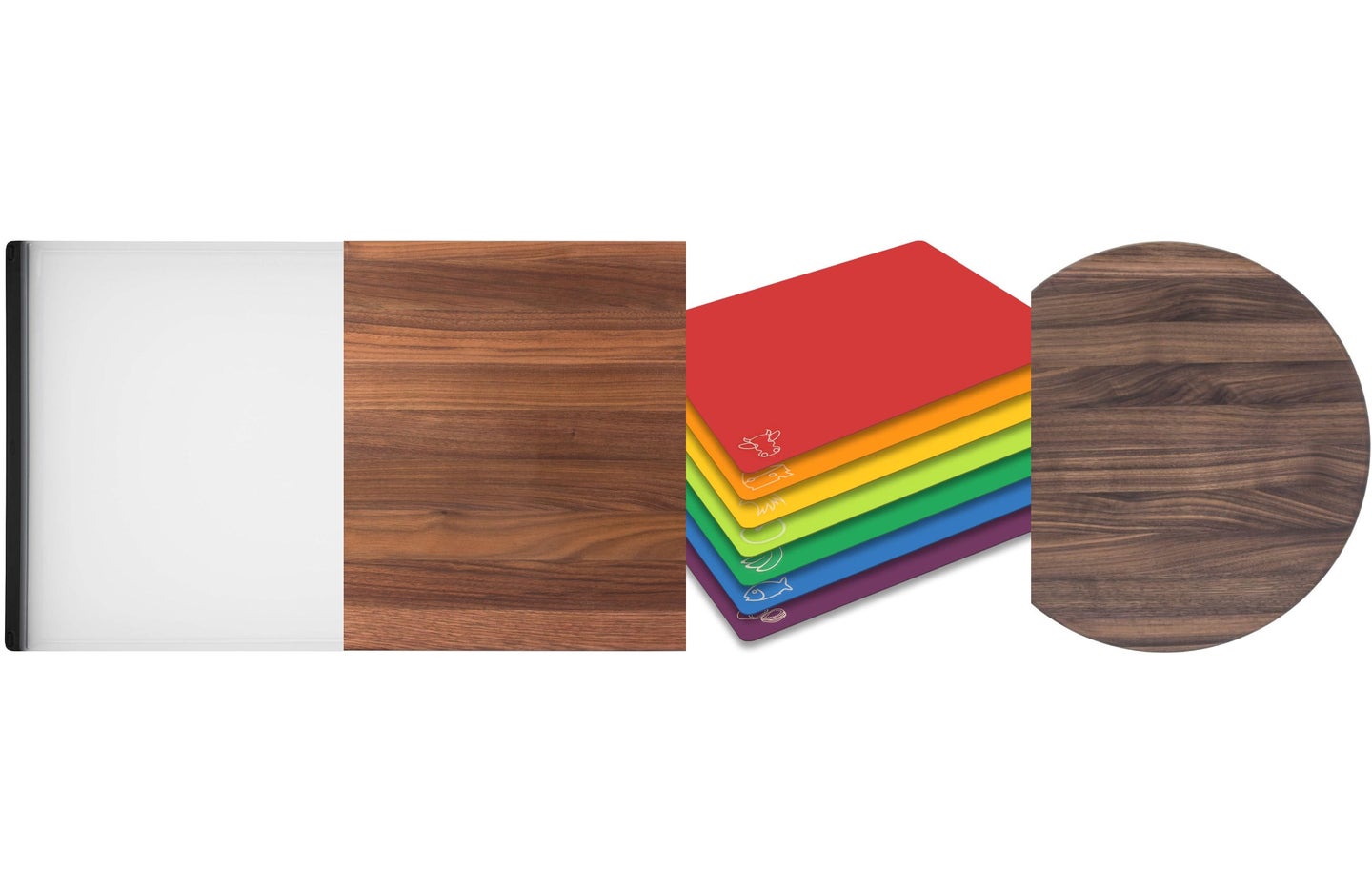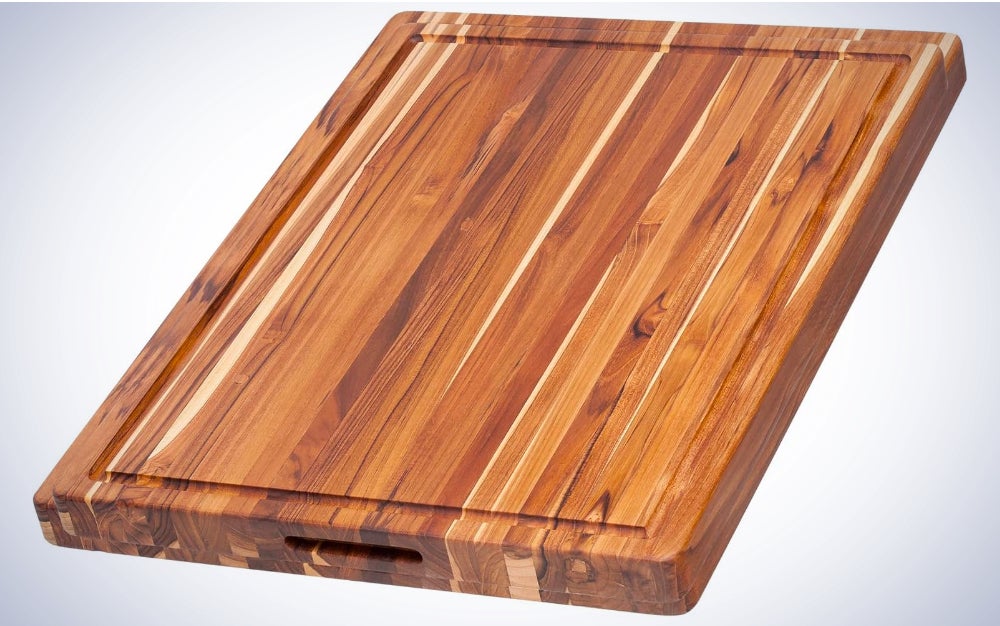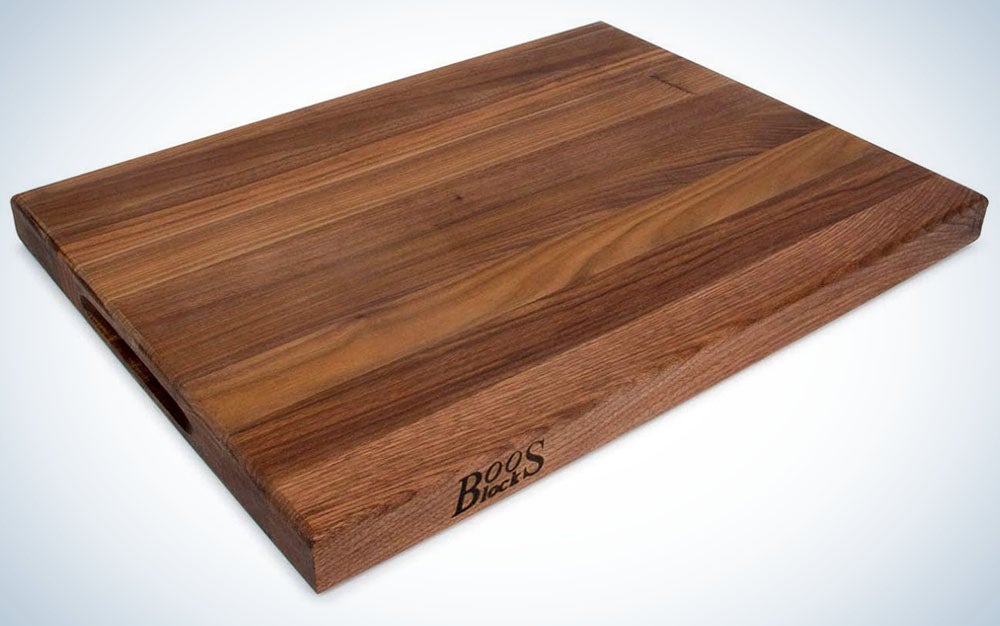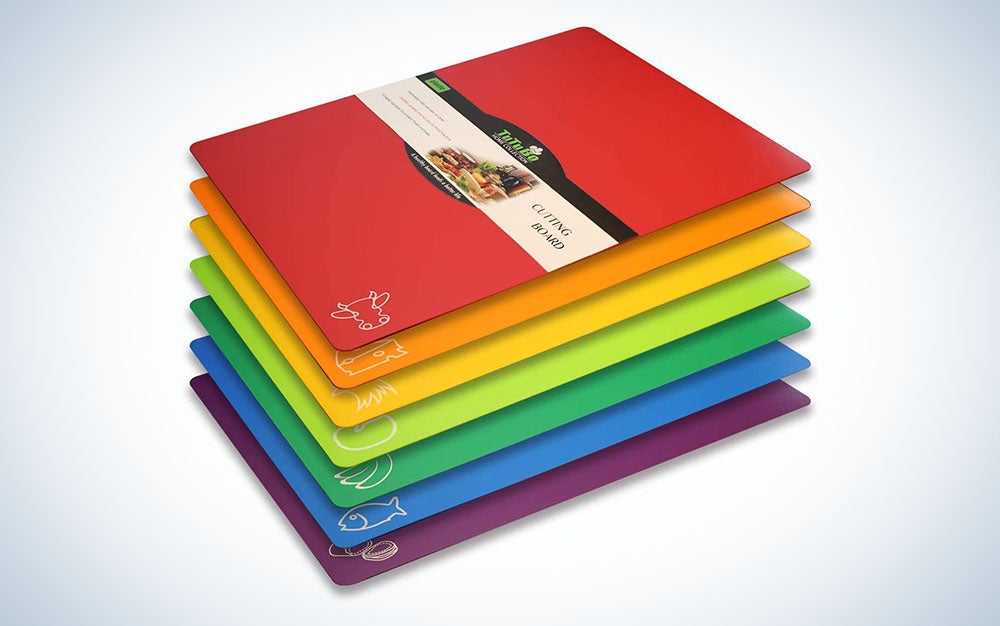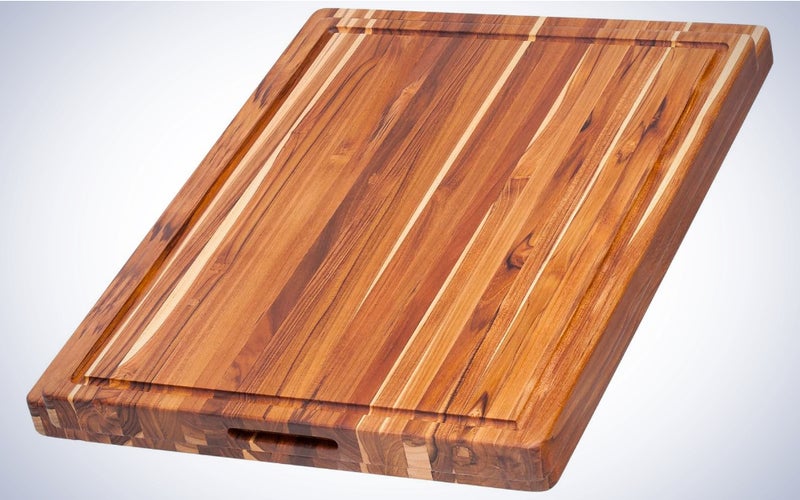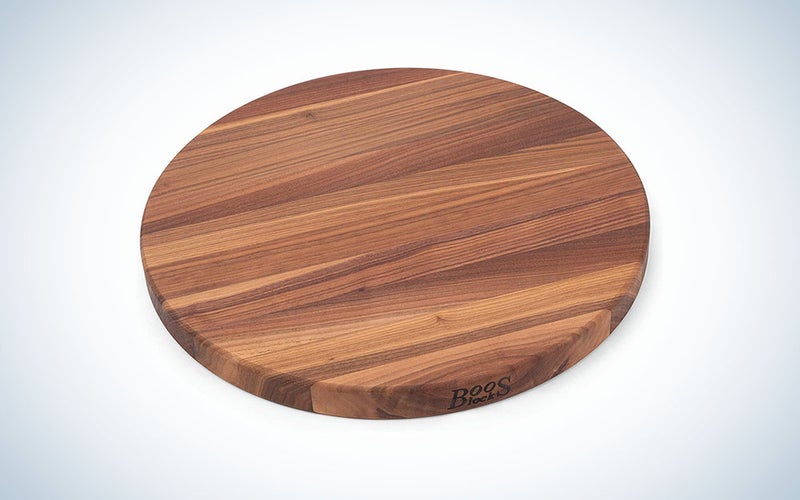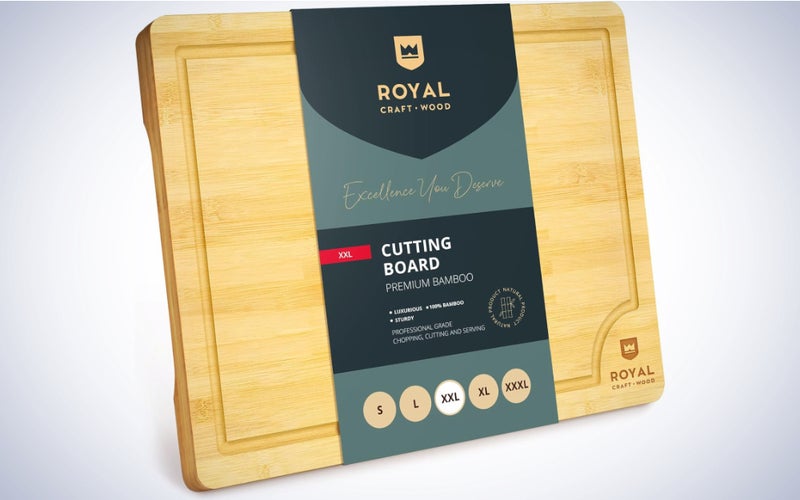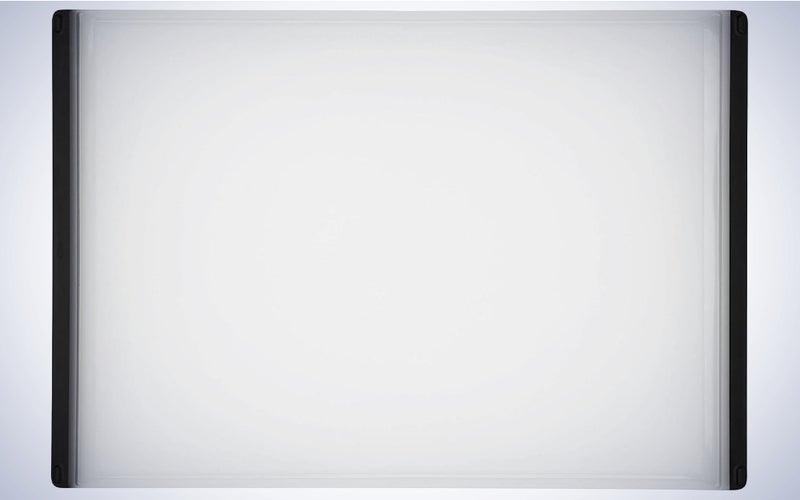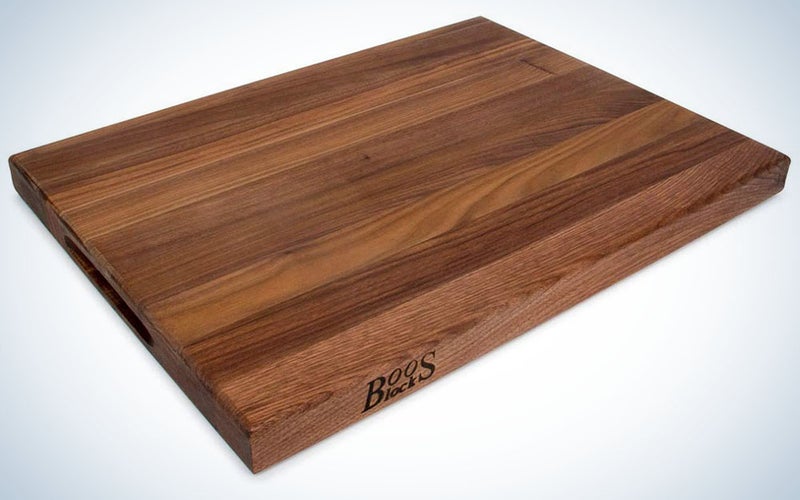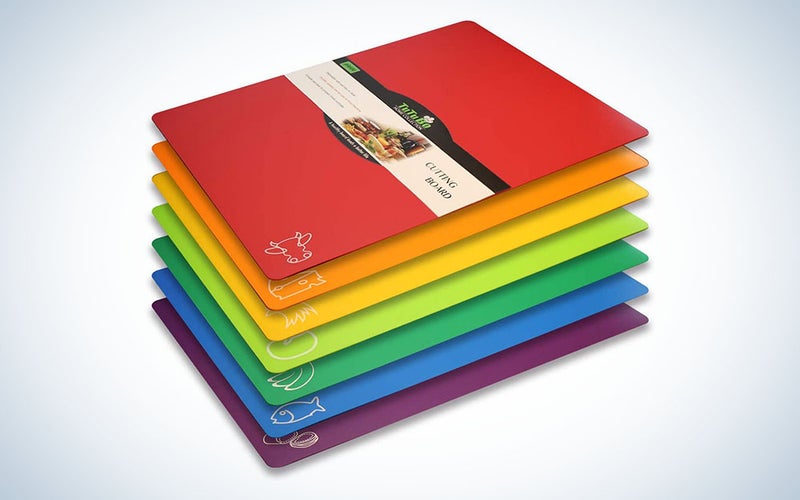We may earn revenue from the products available on this page and participate in affiliate programs. Learn more ›
The purpose of a cutting board is to protect your countertops and knives, and it’s also an organizational must for any chef’s mise en place. The type of surface you choose comes down to multiple factors: your aesthetic preference; what you’ll be cutting, chopping, dicing, and slicing; how much space you have; and how thoroughly you can be trusted to clean it. Whether you want to spend $5 or close to $200, there’s an option for you. In fact, if you cook a lot, you might consider buying more than one board, to eliminate cross-contamination while preparing and guarantee that you have as much surface area as you need. These are the best cutting boards available in a range of materials.
- Best overall: Teakhaus Carving Board
- Best wood: John Boos Block Walnut Wood Cutting Board
- Best bamboo: Extra Large Organic Bamboo Cutting Board with Juice Groove
- Best plastic: OXO Good Grips Plastic Carving & Cutting Board
- Best splurge: John Boos Edge Grain Reversible Cutting Board
- Best budget: Cutting Board Mats Flexible Plastic Colored Mats
How we chose the best cutting boards
We understand every kitchen and home cook is different, so our mindset going into this story was covering every possible base. Our cutting board recommendations vary in size, material, and cost, so your needs will be met regardless of what you like to cook or how much space you have for kitchen accessories. We also considered nice-to-have but non-essential features like whether the cutting board had handles or was designed with a groove to catch drippings. Dishwasher friendliness was also top of mind since cleaning your cutting board by hand can be cumbersome in a small sink.
The best cutting boards: Reviews & Recommendations
Our list of cutting boards will meet the needs of novice home cooks and serious chefs looking to upgrade from their worn ones. A properly cared-for cutting board will last several years before you even think about upgrading and is an essential that should sit permanently between your coffee machine and smart oven.
Best overall: Teakhaus Carving Board
Teakhaus
Specs
- Material: Wood
- Size: 20 x 15 x 1.5 Inches
- Weight: 4.5 pounds
- Price: $98.90
Pros
- Reversible
- Built-in handles
- Drip cavity
Cons
- Not dishwasher safe
Teakhaus’ Carving Board is the platonic ideal of cutting boards. It’s large enough to cut huge hunks of meat, or present an entire meal. A recessed drip cavity around the outer rim of the boards will prevent messes and spills while carving, while handles on either side make it easier to carry. Those handles can be used to flip the board over to use the underside, which lacks the drip cavity but has a large surface area to work with. If you’re slicing up dried meat or putting together a charcuterie board, using the underside of this cutting board makes a lot of sense.
This cutting board is made of wood, so you can’t clean it in the dishwasher, but that’s true of any wooden cooking tool. On the plus side, the wood Teakhaus uses for its cutting boards is certified by the FSC (Forest Stewardship Council) as being made from sustainable materials. Additionally, Teakhaus’ wooden cutting board is a lot less expensive than most wooden cutting boards in its size class.
Best wood: John Boos Block Walnut Wood Cutting Board
Specs
- Material: Wood
- Size: 18 x 18 x 1.5 inches
- Weight: 4 pounds
- Price: $220.95
Pros
- Appealing shape
- Durability
- Can double as a serving platter
Cons
- Price
Boos Blocks are the best-known and most-loved wooden cutting boards in the industry, and for good reason. They’re made from sustainably sourced wood, and come in cherry, walnut, and maple. John Boos offers its cutting boards in a wide range of shapes and sizes, but we’re partial to this circular one because it’s inviting as a serving platter in addition to a cutting board. It’s expensive and doesn’t have the drip cavity that most wooden cutting boards have, but that gives it a more timeless look.
This cutting board is also relatively light for its size, which will make it easier to maneuver from your kitchen counter to the table. While this cutting board is designed to last a lifetime, John Boos recommends applying board cream regularly to ensure its continued durability.
Best bamboo: Extra Large Organic Bamboo Cutting Board with Juice Groove
Royal
Specs
- Material: Wood
- Size: 20 x 14 x 3 Inches
- Weight: 5 pound
- Price: $28.97
Pros
- Dripping cavity
- Available in multiple sizes
- Price
Cons
- Heavy
Royal Craft Wood’s double-sided bamboo cutting board gives you a lot of bang for your buck. It’s water- and odor-resistant, easy to clean, has built-in handles so it can double as a serving tray, and features deep juice grooves to avoid spills. These are all features you’ll find on many of our cutting board recommendations, but Royal Craft Wood charges one-tenth the price. It still has the same limitations as the other wooden cutting boards you’ll find—namely being hand-wash only, but it does come in a range of sizes, from small (12 by 8 by 0.6 inches) to XXXL (24 by 18 by 1.38 inches). If you pick up multiple boards, the company even offers an organizer to keep your kitchen tidy.
Best plastic: OXO Good Grips Plastic Carving & Cutting Board
OXO
Specs
- Material: Plastic
- Size: 21.1 x 14.5 inches
- Weight: 3.42 pounds
- Price: $32.99
Pros
- Double-sided
- Dishwasher safe
- Tapered edges for easy movement
Cons
- Plastic is less environmentally friendly than wood
We’ll cut to the chase: Oxo’s Carving & Cutting Board is the one to get if you care about ease of use, kitchen safety, and overall design. Its non-stick feet will prevent it from moving around on a wet countertop, a drip cavity will keep juices from running over, and its tapered edges make it easy to flip over. We’re particularly impressed by the drip cavity’s easy-pour corners, which make it easier to keep or discard accumulated juices. The biggest benefit to using a plastic cutting board is the ability to clean it in a dishwasher rather than having to hand wash it. While plastic will never be an Earth-friendly material, OXO has committed to donating 1% of its overall revenue to the ecological organization 1% For The Planet, which helps offset it.
Best splurge: John Boos Edge Grain Reversible Cutting Board
Specs
- Material: Wood
- Size: 20 x 15 x 1.5 inches
- Weight: 10.14 pounds
- Price: $220.95
Pros
- Large size
- Built-in handles
- Durability
Cons
- Price
This Boos Block cutting board is similar to the one we recommended earlier but comes in a larger, more traditional shape and has handles for easier maneuverability. This cutting board is large, reversible, and made in the USA. There’s no drip cavity, and it’s an expensive piece of kitchen gear, but you’re getting what you pay for based on the quality of this cutting board’s materials. We’re recommending the walnut cutting board, but it’s also available in maple and cherry too. While it was designed to survive thousands of cuts from a knife, you can keep this cutting board in like-new condition by handwashing it regularly and applying board cream.
Best budget: Fotouzy Cutting Board Mats Flexible Plastic Colored Mats
Specs
- Material: Plastic
- Size: 14.9 x 11.9 x .29 Inches
- Weight: 1 pound
- Price: $16.99
Pros
- Ultra lightweight
- Comes in a set of seven
- Price
Cons
- No drippings cavity
If you’d like an inexpensive addition to your kitchen, you can’t go wrong with a set of seven cutting board mats from Fotouzy. This multipack comes in an array of colors—with coordinating meat, fish, chicken, and veggie symbols—to make keeping your food safe and sans contamination easy. A waffle-grid backing makes sure these don’t slip, but if you have a very wet countertop, you might need to place a paper towel underneath to keep it in place. The best part is that they’re dishwasher-safe!
What to consider when shopping for the best cutting board
If you do any sort of cooking, you probably already own a cutting board: It’s one of the most important and versatile kitchen tools there are. The question is, do you own the right one, and are you taking care of it properly? Here are some things to consider when looking for the best option for your kitchen:
What’s the best material for a cutting board?
The short answer is that it depends on what you’re cutting. In general, wood is sturdy and weighty, which is great if you’re chopping something vigorously and need your surface to stay put. It also won’t dull your knives and typically comes with a border reservoir to catch any liquid runoff from meats and veggies. On the downside, a wood board is not machine-washable. Then there’s bamboo: The eco-friendly material can take a licking, repels moisture, and doesn’t tend to scar as easily as some other materials. Silicone boards aren’t as pretty or classic-looking as their wood and bamboo counterparts. Still, they’re dishwasher-safe, and many are antimicrobial, so you don’t have to worry as much about cross-contamination.
How do I pick a cutting board size and shape?
The truth is, you probably want more than one cutting board in a variety of shapes, sizes, and materials. For example, if you have a lot of counter space, you might want one giant woodblock (e.g., 24 inches by 36 inches, at least 2 inches thick) that stays put and some smaller, lighter silicone models to rotate in and out for smaller jobs, like veggies. Only you know whether you’re more comfortable working with a round or rectangular board, or one (e.g.) with legs for added stability. Maybe you like a handle to hold onto (which then doubles as a way to hang your board on a wall when it’s not in use).
How do I clean a cutting board?
Keeping a cutting board sanitized is crucial. Imagine slicing up a chicken, not cleaning the surface properly, then using the same board to chop up some veggies for your kid. No thank you! Wooden and bamboo boards should be thoroughly cleaned with dish soap and warm water after every use and dried immediately with a towel (so the board doesn’t warp). Most plastic boards can be run through the dishwasher, but for a deep clean, you can rub them down with a teaspoon of bleach mixed with a quart of water, then run under hot water and drip dry.
What is the difference between end grain vs. edge grain?
When it comes to wood boards, end-grain boards look checkered; edge-grain boards look striped. Aesthetically, you may just like one more than the other. (The end-grain options, for example, show the natural rings of the tree from which they’re made.) In terms of how else they differ, an edge-grain board may dull your knives more quickly and get easily scuffed. When a knife edge hits an end-grain board, on the other hand, the blade inserts in and exits out of the wood fibers seamlessly, so your knives will stay sharper longer and your board will stay in good shape longer. Edge-grain boards are typically more affordable.
FAQs
Q: Can I cut meat on a wooden cutting board?
You can cut meat on a wooden cutting board, but you must ensure it has a sealed surface and that you sanitize it properly after every use. (The good news is that wood and its cousin bamboo, which is made from grass, have some naturally anti-microbial properties.) If you don’t trust yourself to thoroughly clean your board every time, opt instead for something dishwasher-friendly like plastic—but take care to make sure it’s getting thoroughly cleaned too.
Q: Which cutting board is most hygienic?
This is one of those six eggs vs. half a dozen situations. Wood and bamboo have natural antimicrobial properties that plastic boards don’t, and once you cut on plastic, you open up lots of grooves and crevices in which bacteria can settle. On the other hand, plastic can go in the dishwasher, where it might get a more thorough wash than the handwashing bamboo and wood require. If you’re going for a wood board, opt for a hardwood (like maple) and not a softwood (like cypress or pine): A hardier wood won’t splinter as easily as a soft one and, therefore, won’t be as prone to bacteria-retaining knicks and cuts.
Q: What kind of cutting board does Gordon Ramsay use?
According to his Masterclass, the world-renowned chef counts the Boos block as part of his kitchen tools essentials but says that any wooden board that’s 24 inches by 18 inches and slip-proof will do.
Q: How much does a cutting board cost?
This depends on its size and materials, but our recommendations range in price between $17 and $220.
Final thoughts on the best cutting boards
- Best overall: Teakhaus Carving Board
- Best wood: John Boos Block Walnut Wood Cutting Board
- Best bamboo: Extra Large Organic Bamboo Cutting Board with Juice Groove
- Best plastic: OXO Good Grips Plastic Carving & Cutting Board
- Best splurge: John Boos Edge Grain Reversible Cutting Board
- Best budget: Cutting Board Mats Flexible Plastic Colored Mats
No matter your price point or skill level, there’s a board out there that will instantly help your food prep and presentation. If you want to do whatever the cool professional chefs do, go for a solid wood block with an end grain; if ease of use and cleanup is essential, pick a dishwasher-friendly silicone model. Regardless of your choice, there’s a pick out there that’s cut out for your cooking. Pick one out and do your worst!
Why trust us
Popular Science started writing about technology more than 150 years ago. There was no such thing as “gadget writing” when we published our first issue in 1872, but if there was, our mission to demystify the world of innovation for everyday readers means we would have been all over it. Here in the present, PopSci is fully committed to helping readers navigate the increasingly intimidating array of devices on the market right now.
Our writers and editors have combined decades of experience covering and reviewing consumer electronics. We each have our own obsessive specialties—from high-end audio to video games to cameras and beyond—but when we’re reviewing devices outside of our immediate wheelhouses, we do our best to seek out trustworthy voices and opinions to help guide people to the very best recommendations. We know we don’t know everything, but we’re excited to live through the analysis paralysis that internet shopping can spur so readers don’t have to.
